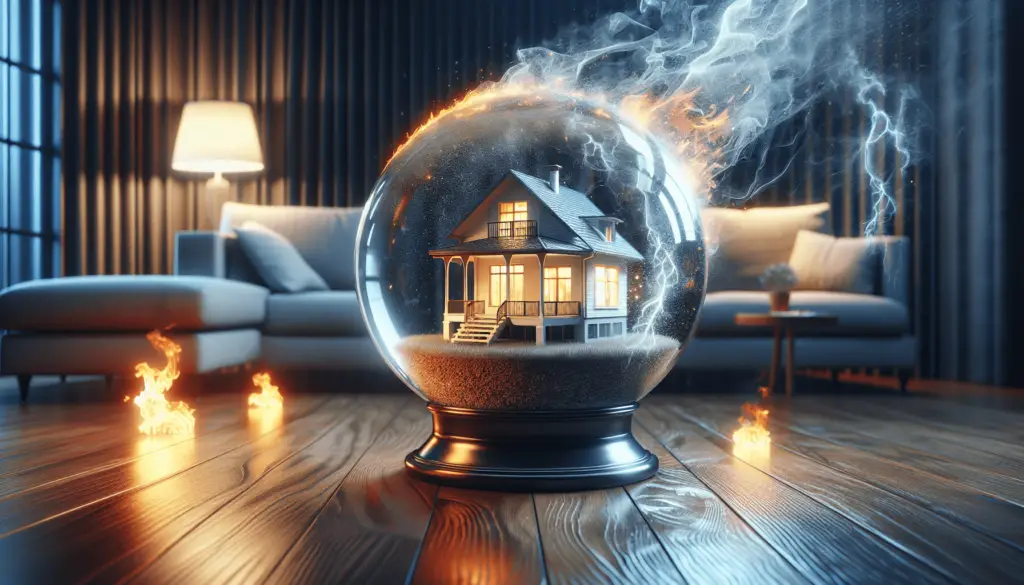Imagine a world where you have all the knowledge and tools to assess your home’s readiness for a disaster. Picture yourself confidently navigating through your living space, identifying potential hazards, and making informed decisions about how to prepare for the unexpected. In this article, we will guide you through the essential steps of assessing your home’s readiness for a disaster, empowering you to protect yourself, your loved ones, and your cherished belongings. Together, let’s create a safe haven in the face of adversity.
Identify potential hazards
When assessing your home’s readiness for a disaster, the first step is to identify potential hazards. By understanding the common disasters that occur in your area, you can better prepare for them. Research common disasters in your area, such as hurricanes, earthquakes, wildfires, or floods. This will give you an idea of the specific risks you are likely to face. Additionally, consider any unique risks in your neighborhood. For example, if you live near a chemical plant or in a high-crime area, there may be additional hazards to take into account. Finally, look for potential hazards in and around your home. Are there any old trees that could fall during a storm? Are there any loose railings or steps that could pose a risk? By identifying these potential hazards, you can take proactive steps to mitigate them and keep you and your home safe.
Check your emergency supplies
Having an emergency supply kit is crucial for any disaster situation. It should contain essential items that can sustain you and your family for at least three days. Ensure that your emergency supply kit is well-stocked and easily accessible. Some basic items to include are non-perishable food items, bottled water, a first aid kit, flashlights with extra batteries, a battery-powered or hand-crank radio, and essential medications. Regularly review and replenish your supplies to ensure that everything is up-to-date and in working order. Replace any expired food or medications, and check the batteries in your flashlights and radio. By being prepared with a well-stocked emergency supply kit, you can have peace of mind knowing that you are ready for any unexpected situation.

Review your home insurance
Home insurance is an essential safeguard in case of a disaster. Take the time to review your policy coverage and understand what is covered and what is not. Make sure your policy adequately covers the potential hazards in your area. For example, if you live in a flood-prone area, you may need to consider additional flood insurance. Consider adding specific coverage for disasters such as earthquakes or wildfires if they are common in your region. It is also important to document your belongings and keep records in case you need to make a claim. Take photos or videos of your home and its contents, and store them in a safe place. Keep receipts for valuable items, and consider keeping copies of important documents off-site or in a secure digital format. By reviewing your home insurance and documenting your belongings, you can ensure that you are prepared in the event of a disaster.
Assess your home’s structural integrity
The structural integrity of your home is paramount during a disaster. Take the time to inspect the foundation, walls, and roof for any signs of damage or weakness. Look for cracks in the foundation, water damage on the walls or ceiling, and loose or missing shingles on the roof. These could be indications of structural problems that need to be addressed. Additionally, check for vulnerabilities in windows and doors. Are they properly sealed and secure? Consider reinforcing them with storm shutters or impact-resistant glass. It is also important to secure heavy furniture and fixtures to prevent them from toppling over during an earthquake or high winds. By assessing your home’s structural integrity and making necessary repairs or upgrades, you can increase its resilience to disasters.

Develop an emergency plan
Having a well-thought-out emergency plan can make a significant difference during a disaster. Create a communication plan that includes emergency contact numbers and designate a meeting point for your family members in case you are separated. Assign responsibilities to each family member, such as gathering the emergency supply kit or shutting off utilities, so everyone knows what to do in an emergency. Practice your emergency plan regularly to ensure that everyone is familiar with their roles and responsibilities. By developing an emergency plan and practicing it with your family, you can be better prepared to handle a disaster situation.
Prepare for power outages
Power outages often accompany disasters, so it is important to be prepared. Invest in backup power sources such as a generator or a battery-powered inverter. These can provide temporary power to essential appliances and devices, such as refrigerators or medical equipment. Have alternative lighting options available, such as flashlights, lanterns, or solar-powered lights. It is crucial to learn how to safely operate a generator to prevent carbon monoxide poisoning or electrical hazards. Familiarize yourself with the manufacturer’s instructions and follow all safety precautions. By preparing for power outages, you can ensure that you have the necessary resources to navigate through a disaster.
Secure important documents and valuables
Protecting your important documents and valuables should be a priority in disaster preparedness. Store important documents, such as birth certificates, passports, insurance policies, and property deeds, in a waterproof and fireproof container. This will help ensure their safety in case of a disaster. It is also a good practice to make digital copies of important records and store them in a secure location, such as a cloud storage service or an external hard drive. Safely secure valuables, such as jewelry or irreplaceable family heirlooms, in a safe or lockbox that is bolted down or hidden in a secure location. By taking these precautions, you can protect your valuable possessions and important documents from potential damage or loss during a disaster.
Maintain your property
Regularly maintaining your property helps reduce the risk of damage during a disaster. Keep trees and bushes trimmed, especially those close to your home. Overhanging branches or tall vegetation can pose a hazard during high winds or storms. Clear gutters and drains regularly to ensure proper water flow and prevent water damage to your home. Secure loose items in your yard, such as patio furniture, grills, or gardening tools, to prevent them from becoming projectiles during strong winds. By maintaining your property, you can minimize potential hazards and protect your home from avoidable damage.
Stay informed about local alerts and warnings
Staying informed is crucial during a disaster. Sign up for emergency notifications from your local authorities to receive alerts and updates directly. This will keep you informed about any potential threats or evacuation orders in your area. Additionally, follow local news and weather updates to stay informed about the current situation. Having a battery-powered or hand-crank radio can also provide you with important information, especially if other forms of communication are not available. By staying informed, you can make informed decisions and take appropriate actions to ensure your safety and that of your family.
Practice emergency drills
It is important to practice emergency drills to ensure that you and your family are prepared to respond effectively in a disaster situation. Conduct fire drills in your home to familiarize everyone with escape routes and emergency procedures. Practice evacuation routes, both from your home and your neighborhood, and designate meeting points in safe locations. Review first aid and CPR techniques regularly to ensure that you are equipped with the necessary skills to help others in an emergency. By practicing emergency drills, you can improve your response time and increase your chances of staying safe during a disaster.
Assessing your home’s readiness for a disaster is an essential step in ensuring the safety and well-being of you and your family. By identifying potential hazards, checking your emergency supplies, reviewing your home insurance, assessing your home’s structural integrity, developing an emergency plan, preparing for power outages, securing important documents and valuables, maintaining your property, staying informed about local alerts and warnings, and practicing emergency drills, you can be well-prepared to face any unexpected situation with confidence. Remember, disaster preparedness is a continuous process, so regularly reviewing and updating your readiness measures is crucial. Stay safe and be prepared!
